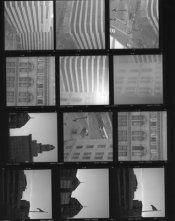Hello,
Some folks proof simply to have a nice proofsheet, while others might proof as a precursor to printing. The nice proofsheet is fun to look at and fun to show to others, while the other type is simply a tool for the printer.
I am of the school who prints contact sheets at a predetermined time and aperture, no matter how good or bad it looks, in order to get a jump on the printing.
Anyhow, I consider my "normal" paper grade to be a grade three. That way, with today's limited selection of grades, I have one grade above normal and one grade below it. So, all of my proofsheets go on grade three paper, and if I have the time, I do them in a contact frame instead of through the film sleeves. (This also means that my "good" negs are flatter than most people's, who aim for a grade two paper.)
Also, I never need to do test strips, because I know what my "normal" time and aperture are (at a certain enlarger height that I use for contact sheets) that will make a black black, a middle grey middle grey, and a white white for the particular paper I am using.
So, the proofsheet gives me a good idea of where to start when printing. Additionally, since I do them with a contact frame instead of through the sleeves, I know what is tack sharp and what is not without having to look at the film.
I also have noticed that the higher you raise the enlarger, the more contrast is lost between neg. and print, so for a standard sized print, which I consider to 11x14 for all my initial calibration of film, developer, and printing, the contrast on the neg. might be fine, but will look slightly contrasty on the proofsheet; perhaps 1/2 grade more so.
I don't think scanning would be very time effective or helpful to the analog printing process, but probably would be if you print electronically. Scanning an analog proofsheet might make things easier if you plan on printing analog, but have to send a proofsheet to someone electronically.
Also, this of course means that I always contact onto the paper onto which I will be printing, and very often will make the contacts onto a few different papers. I use a handful of papers for most of my printing, and have a bunch of really old paper (some expired in 1949) that I use for more experimental stuff. My normal papers are: Oriental graded for neutral tone, Fotokemika Emaks graded for warm tone, Ilford MG FB Warmtone glossy for a warm-tone VC paper that looks very different than Emaks, and is just beautiful for certain things (although WAY overpriced), and Ilford MG RC pearl for when I want that RC look, which I very much like sometimes.














